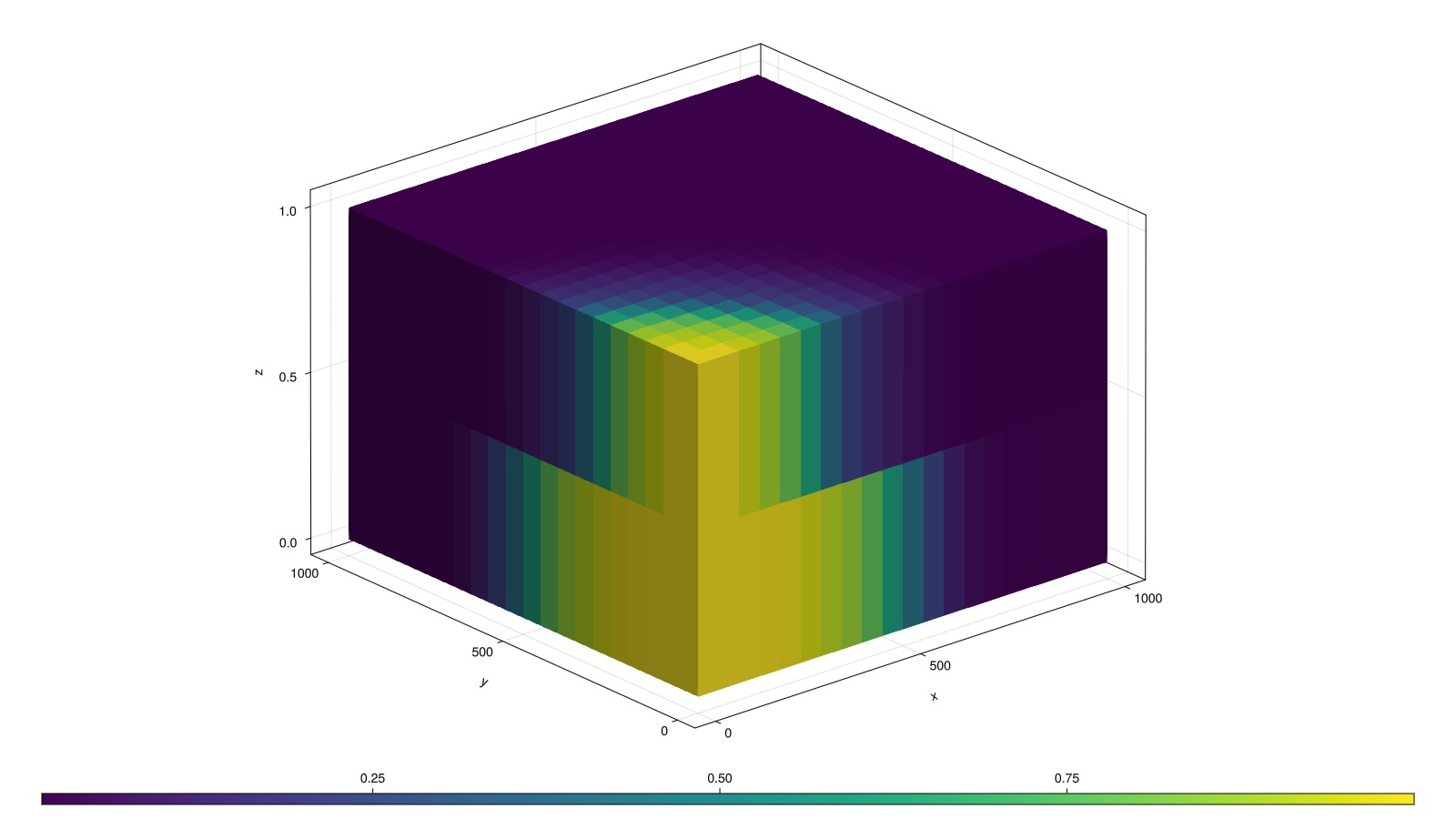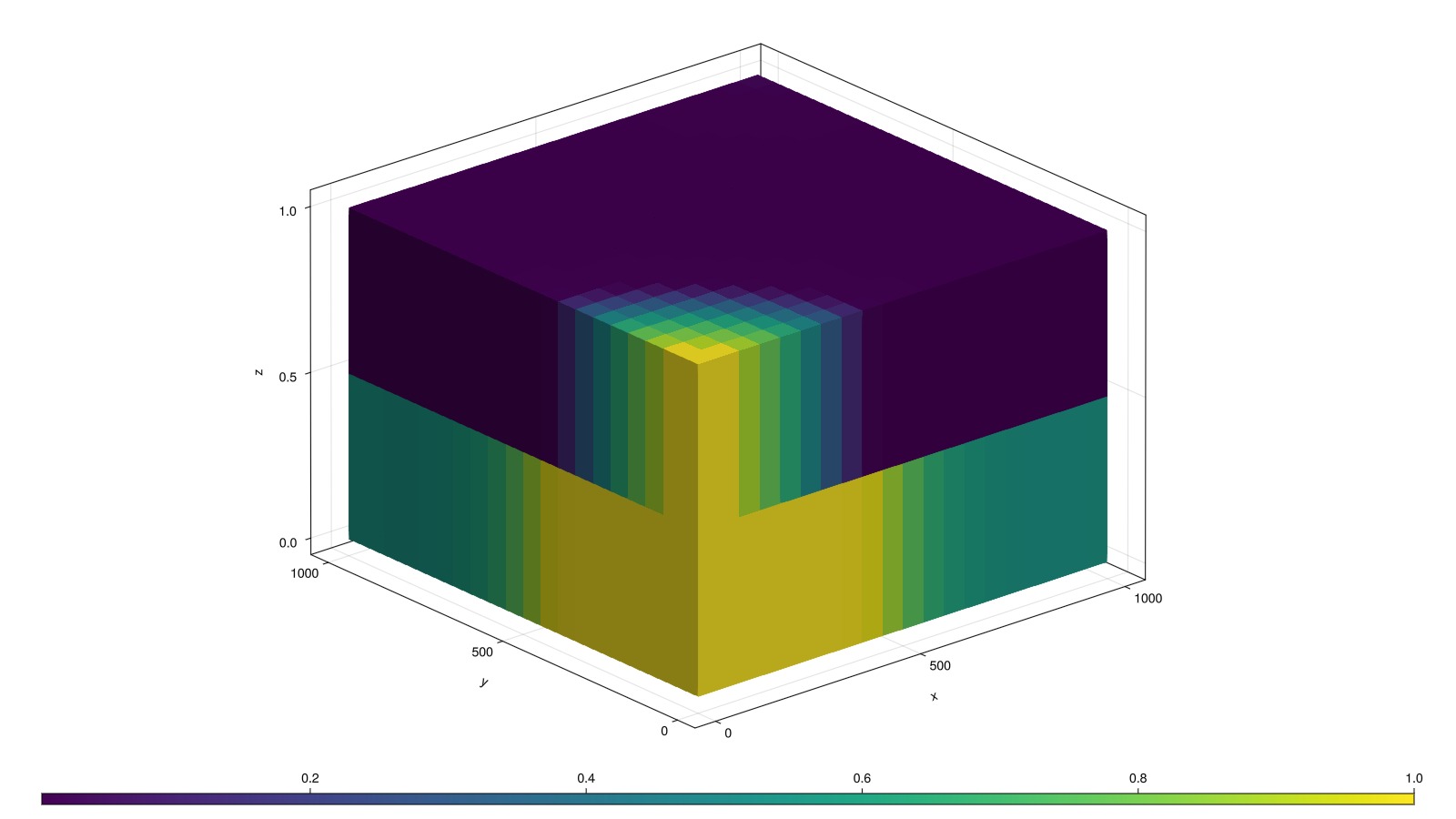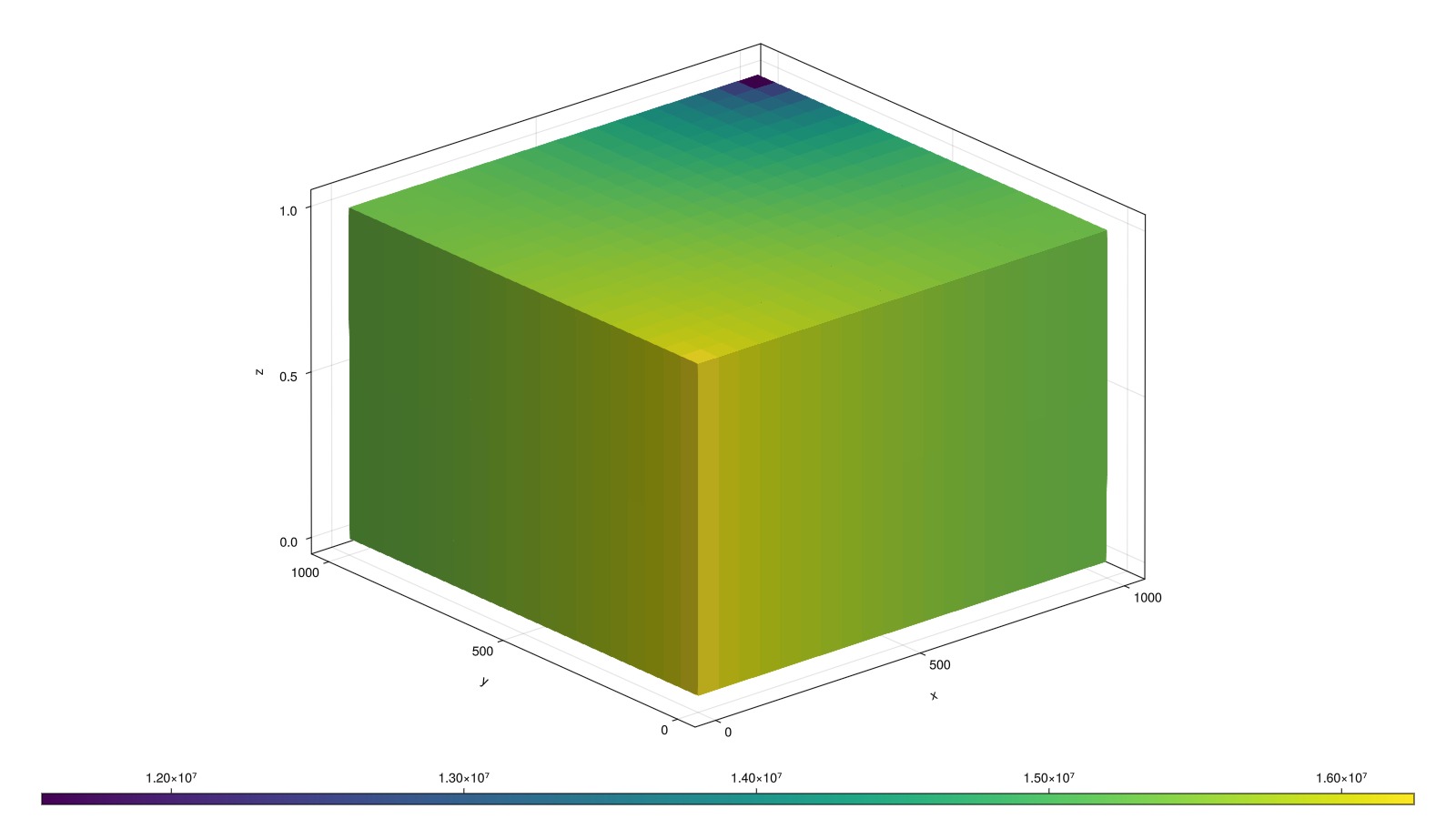A more complex compositional model
CompositionalThis example sets up a more complex compositional simulation with five different components. Other than that, the example is similar to the others that include wells and is therefore not commented in great detail.
julia
using MultiComponentFlash
n2_ch4 = MolecularProperty(0.0161594, 4.58e6, 189.515, 9.9701e-05, 0.00854)
co2 = MolecularProperty(0.04401, 7.3866e6, 304.200, 9.2634e-05, 0.228)
c2_5 = MolecularProperty(0.0455725, 4.0955e6, 387.607, 2.1708e-04, 0.16733)
c6_13 = MolecularProperty(0.117740, 3.345e6, 597.497, 3.8116e-04, 0.38609)
c14_24 = MolecularProperty(0.248827, 1.768e6, 698.515, 7.2141e-04, 0.80784)
bic = [0.11883 0.00070981 0.00077754 0.01 0.011;
0.00070981 0.15 0.15 0.15 0.15;
0.00077754 0.15 0 0 0;
0.01 0.15 0 0 0;
0.011 0.15 0 0 0]
mixture = MultiComponentMixture([n2_ch4, co2, c2_5, c6_13, c14_24], A_ij = bic, names = ["N2-CH4", "CO2", "C2-5", "C6-13", "C14-24"])
eos = GenericCubicEOS(mixture, PengRobinson())
using Jutul, JutulDarcy, GLMakie
Darcy, bar, kg, meter, Kelvin, day = si_units(:darcy, :bar, :kilogram, :meter, :Kelvin, :day)
nx = ny = 20
nz = 2
dims = (nx, ny, nz)
g = CartesianMesh(dims, (1000.0, 1000.0, 1.0))
nc = number_of_cells(g)
K = repeat([0.05*Darcy], 1, nc)
res = reservoir_domain(g, porosity = 0.25, permeability = K, temperature = 387.45*Kelvin)DataDomain wrapping CartesianMesh (3D) with 20x20x2=800 cells with 20 data fields added:
800 Cells
:permeability => 1×800 Matrix{Float64}
:porosity => 800 Vector{Float64}
:rock_thermal_conductivity => 800 Vector{Float64}
:fluid_thermal_conductivity => 800 Vector{Float64}
:rock_heat_capacity => 800 Vector{Float64}
:component_heat_capacity => 800 Vector{Float64}
:rock_density => 800 Vector{Float64}
:temperature => 800 Vector{Float64}
:cell_centroids => 3×800 Matrix{Float64}
:volumes => 800 Vector{Float64}
1920 Faces
:neighbors => 2×1920 Matrix{Int64}
:areas => 1920 Vector{Float64}
:normals => 3×1920 Matrix{Float64}
:face_centroids => 3×1920 Matrix{Float64}
3840 HalfFaces
:half_face_cells => 3840 Vector{Int64}
:half_face_faces => 3840 Vector{Int64}
960 BoundaryFaces
:boundary_areas => 960 Vector{Float64}
:boundary_centroids => 3×960 Matrix{Float64}
:boundary_normals => 3×960 Matrix{Float64}
:boundary_neighbors => 960 Vector{Int64}Set up a vertical well in the first corner, perforated in all layers
julia
prod = setup_vertical_well(g, K, nx, ny, name = :Producer)DataDomain wrapping SimpleWell [Producer] (1 nodes, 0 segments, 2 perforations) with 20 data fields added:
2 Perforations
:Kh => 2 Vector{Float64}
:skin => 2 Vector{Float64}
:perforation_radius => 2 Vector{Float64}
:well_index => 2 Vector{Float64}
:perforation_centroids => 3×2 Matrix{Float64}
:drainage_radius => 2 Vector{Float64}
:perforation_direction => 2 Vector{Symbol}
:cell_dims => 2 Vector{Tuple{Float64, Float64, Float64}}
:thermal_well_index => 2 Vector{Float64}
:net_to_gross => 2 Vector{Float64}
:permeability => 1×2 Matrix{Float64}
1 Cells
:cell_length => 1 Vector{Float64}
:radius => 1 Vector{Float64}
:radius_inner => 1 Vector{Float64}
:cell_centroids => 3×1 Matrix{Float64}
:volume_multiplier => 1 Vector{Float64}
:casing_thickness => 1 Vector{Float64}
:grouting_thickness => 1 Vector{Float64}
:casing_thermal_conductivity => 1 Vector{Float64}
:grouting_thermal_conductivity => 1 Vector{Float64}Set up an injector in the opposite corner, perforated in all layers
julia
inj = setup_vertical_well(g, K, 1, 1, name = :Injector)
rhoLS = 1000.0*kg/meter^3
rhoVS = 100.0*kg/meter^3
rhoS = [rhoLS, rhoVS]
L, V = LiquidPhase(), VaporPhase()(LiquidPhase(), VaporPhase())Define system and realize on grid
julia
sys = MultiPhaseCompositionalSystemLV(eos, (L, V))
model = setup_reservoir_model(res, sys, wells = [inj, prod], block_backend = true);
kr = BrooksCoreyRelativePermeabilities(sys, 2.0, 0.0, 1.0)
model = replace_variables!(model, RelativePermeabilities = kr)
push!(model[:Reservoir].output_variables, :Saturations)
state0 = setup_reservoir_state(model, Pressure = 225*bar, OverallMoleFractions = [0.463, 0.01640, 0.20520, 0.19108, 0.12432]);
dt = repeat([2.0]*day, 365)
rate_target = TotalRateTarget(0.0015)
I_ctrl = InjectorControl(rate_target, [0, 1, 0, 0, 0], density = rhoVS)
bhp_target = BottomHolePressureTarget(100*bar)
P_ctrl = ProducerControl(bhp_target)
controls = Dict()
controls[:Injector] = I_ctrl
controls[:Producer] = P_ctrl
forces = setup_reservoir_forces(model, control = controls)
ws, states = simulate_reservoir(state0, model, dt, forces = forces);Jutul: Simulating 1 year, 52.11 weeks as 365 report steps
╭────────────────┬───────────┬───────────────┬──────────╮
│ Iteration type │ Avg/step │ Avg/ministep │ Total │
│ │ 365 steps │ 367 ministeps │ (wasted) │
├────────────────┼───────────┼───────────────┼──────────┤
│ Newton │ 2.07123 │ 2.05995 │ 756 (0) │
│ Linearization │ 3.07671 │ 3.05995 │ 1123 (0) │
│ Linear solver │ 9.98904 │ 9.9346 │ 3646 (0) │
│ Precond apply │ 19.9781 │ 19.8692 │ 7292 (0) │
╰────────────────┴───────────┴───────────────┴──────────╯
╭───────────────┬─────────┬────────────┬─────────╮
│ Timing type │ Each │ Relative │ Total │
│ │ ms │ Percentage │ s │
├───────────────┼─────────┼────────────┼─────────┤
│ Properties │ 36.2904 │ 54.22 % │ 27.4356 │
│ Equations │ 4.6552 │ 10.33 % │ 5.2278 │
│ Assembly │ 3.4582 │ 7.68 % │ 3.8836 │
│ Linear solve │ 2.2841 │ 3.41 % │ 1.7268 │
│ Linear setup │ 4.8738 │ 7.28 % │ 3.6846 │
│ Precond apply │ 0.2182 │ 3.14 % │ 1.5910 │
│ Update │ 1.5673 │ 2.34 % │ 1.1849 │
│ Convergence │ 2.5722 │ 5.71 % │ 2.8886 │
│ Input/Output │ 0.5197 │ 0.38 % │ 0.1907 │
│ Other │ 3.6818 │ 5.50 % │ 2.7835 │
├───────────────┼─────────┼────────────┼─────────┤
│ Total │ 66.9273 │ 100.00 % │ 50.5970 │
╰───────────────┴─────────┴────────────┴─────────╯Once the simulation is done, we can plot the states
CO2 mole fraction
julia
sg = states[end][:OverallMoleFractions][2, :]
fig, ax, p = plot_cell_data(g, sg)
fig
Gas saturation
julia
sg = states[end][:Saturations][2, :]
fig, ax, p = plot_cell_data(g, sg)
fig
Pressure
julia
p = states[end][:Pressure]
fig, ax, p = plot_cell_data(g, p)
fig
Example on GitHub
If you would like to run this example yourself, it can be downloaded from the JutulDarcy.jl GitHub repository as a script, or as a Jupyter Notebook
This example took 95.40055109 seconds to complete.This page was generated using Literate.jl.